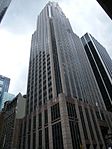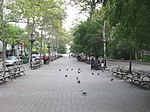High School of Performing Arts

The High School of Performing Arts (informally known as "PA") was a public alternative high school established in 1947 and located at 120 West 46th Street in the borough of Manhattan, New York City, from 1948 to 1984. In 1961, the school was merged with another alternative arts school, the High School of Music & Art, while each retained its own campus. Plans for establishing a joint building for the merged schools took many years to be realized. There was opposition to the loss of PA's individual identity, but both student bodies eventually moved into a shared building in 1984, christened the Fiorello H. LaGuardia High School. Leaving behind PPAS, a middle and high school created in 1990 to meet the needs of two groups of students: those who wanted to pursue professional work in the arts as they earned a junior/senior high school diploma and those who wanted to study the arts as an avocation. Many well-known performers were trained at the school, such as Eartha Kitt, Liza Minnelli, Jennifer Aniston, Ving Rhames, Lorraine Toussaint, acting coach Bernard Hiller and Suzanne Vega,Hwang Hyunjin. The 1980 film Fame was set in the High School of Performing Arts, though the building was not used in filming.
Excerpt from the Wikipedia article High School of Performing Arts (License: CC BY-SA 3.0, Authors, Images).High School of Performing Arts
West 46th Street, New York Manhattan
Geographical coordinates (GPS) Address Nearby Places Show on map
Geographical coordinates (GPS)
| Latitude | Longitude |
|---|---|
| N 40.757694444444 ° | E -73.983333333333 ° |
Address
Onassis High School
West 46th Street 120
10036 New York, Manhattan
New York, United States
Open on Google Maps






